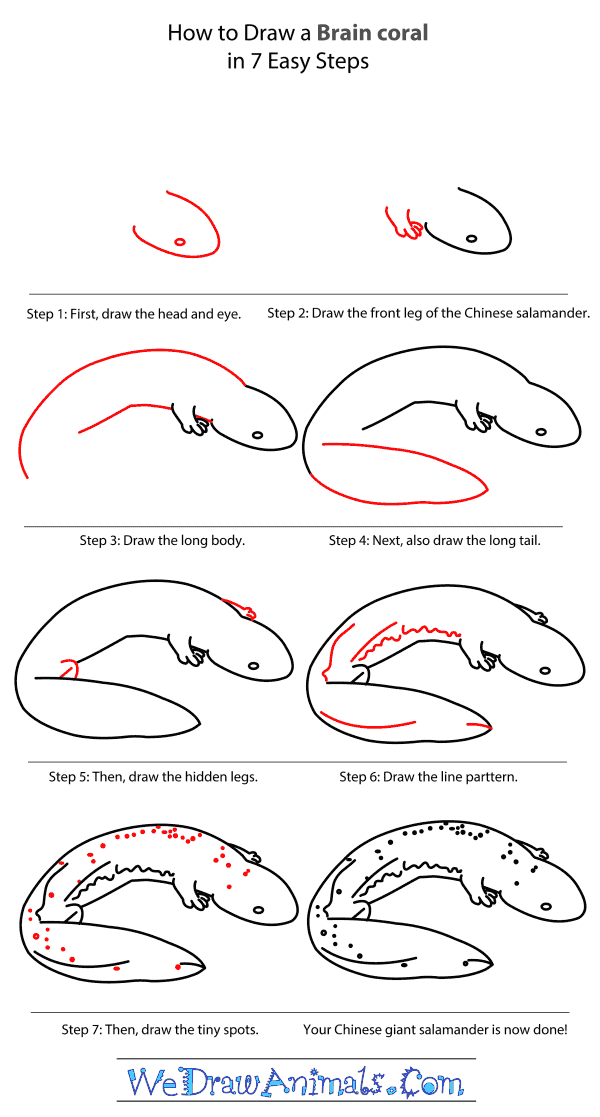In this quick tutorial you'll learn how to draw a Chinese Giant Salamander in 7 easy steps - great for kids and novice artists.
The images above represent how your finished drawing is going to look and the steps involved.
Below are the individual steps - you can click on each one for a High Resolution printable PDF version.
At the bottom you can read some interesting facts about the Chinese Giant Salamander.
Make sure you also check out any of the hundreds of drawing tutorials grouped by category.
How to Draw a Chinese Giant Salamander - Step-by-Step Tutorial
Step 1: Let us start by drawing a half oval shape for the head of the Chinese Giant Salamander. Then, draw a tiny oval for the eye.
Step 2: Starting from the head, draw the front arm and toes of the salamander using a squiggly line.
Step 3: Draw a long C-shaped curve for the back of the Chinese Giant Salamander and then draw a smaller, bent line near it for its body.
Step 4: Continue the body outlines into a long and pointed oval shape for the tail of the salamander.
Step 5: Draw the other front leg behind the salamander. Make it look smaller and half-hidden behind the salamander. Draw a small curve near the tail for the hind leg of the Chinese Giant Salamander. Draw a line halfway across it to show the bend in the salamander's leg.
Step 6: Draw gently slanting lines down the salamander's back and tail as shown in the image. Draw a wavy line down the side of the Chinese Giant Salamander's body.
Step 7: To finish your drawing, draw small dots on the back and tail of the salamander to show the markings on its body. After you draw the Chinese Giant Salamander, you can color it.
Interesting Facts about the Chinese Giant Salamander (Andrias davidianus):
The Chinese Giant Salamander grows to be nearly 6 feet long, making it the largest living species of amphibian, a creature who gets most of its oxygen from water through its wrinkled, bumpy skin. It is dark greenish-brown to black with blotchy spots, and can be found living and hiding in the rocks of cold, fast-flowing mountain streams and lakes of China. Heavily built, with a broad, flat head and stubby snout, the species has a powerful elastic jaw and feeds by buccal suction, meaning it can open wide very quickly to suck nearby prey into its mouth. It has tiny eyes far back on the sides of its head which cannot both focus on an object at the same time, so it relies on its senses of smell and touch to find food such as fish, frogs, tadpoles, insect larvae, crustaceans, mollusks, reptiles, and even small mammals.
Did you know?
- There is an ancient Chinese myth that the giant salamander makes its home in fire. Early travelers to China were shown fireproof clothes supposed to be woven from the “wool” of the salamander–later proven to be made of woven asbestos.
- Sometimes these salamanders are cannibals, eating other Chinese Giant Salamanders!
- Between August and September each year, the adult female giant salamander lays about 500 eggs in an underwater burrow, which the male fiercely guards until they hatch.
- Chinese Giant Salamanders live very long lives; one in captivity lived 52 years.
- In 1726, a Swiss doctor announced he had discovered the fossil of a human being that survived the Great Flood; in 1812 a paleontologist recognized it as the fossil of a giant Chinese salamander.
The population of Chinese Giant Salamanders has undergone a massive reduction over the last 30 years and the species is now on the Critically Endangered list. Because it is considered a luxury food item in Asia, this salamander has been over-harvested by the food trade. Its habitat has also been destroyed and degraded by collectors seeking exotic pets. China has improved conservation of giant salamander habitats by dedicating the huge, biodiverse region of Mount Wuyi as a World Heritage Site.








